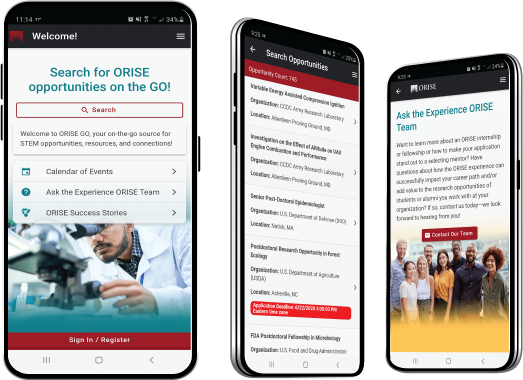Resolving the Atmospheric Life-cycle of Pollution from Combustion Processes in the U.S.
A complete application consists of:
- An application
- Transcripts – Click here for detailed information about acceptable transcripts
- A current resume/CV, including academic history, employment history, relevant experiences, and publication list
- Two educational or professional references
All documents must be in English or include an official English translation.
If you have questions, send an email to EPArpp@orau.org. Please include the reference code for this opportunity in your email.
A postgraduate research opportunity is currently available at the U.S. Environmental Protection Agency’s (EPA) Office of Research and Development/National Exposure Research Laboratory (NERL). The appointment will be served with the Computational Exposure Division (CED) in Research Triangle Park,NC.
Combustion processes including traffic, power plants, and fires, etc., emit a staggering variety of pollutants to the atmosphere in the form of particles or vapor-phase precursors to particles, and a substantial fraction of these particles are made of organic compounds (Seinfeld and Pandis, 2016). Because human exposure to ambient particles has been linked consistently to impacts on human health, it is necessary that we achieve a robust, reliable, and quantitative understanding of 1) the sources of atmospheric organic compounds, 2) the distribution of particle sizes that are directly emitted, 3) the likelihood with which particle-relevant compounds deposit through rain or dry uptake to the ground and 4) the sensitivity of airborne particulate matter exposure to processes that humans can control. There are large uncertainties with respect to all of these issues, but advances in air quality model algorithms and laboratory/field techniques now allow us to address research questions with greater rigor than ever before.
This research project leverages the state-of-the-art Community Multiscale Air Quality (CMAQ) model in order to investigate key processes involved in the sources and fate of combustion-related organic compounds their impacts at a national scale (see e.g. Murphy et al., 2017). Recently, new parameterizations have been implemented to better capture the particle size and volatility of emissions from traffic and wood burning sources. These advances will allow the research participant to pursue an in-depth analysis of complementary observations from intensive measurement campaigns like the Wintertime INvestigation of Transport, Emissions, and Reactivity aircraft investigation (WINTER; Thornton et al., 2014). To perform these analyses, the research participant may compare model predictions to observations of features like particle abundance, organic aerosol volatility/functionality, cloud-aerosol interactions, vertical structure of atmospheric pollutants, and deposition pathways, depending on the candidate’s experience and interest.
The research participant may be closely engaged with the CMAQ model development team, participate in division seminars, and meet with colleagues in other EPA offices working on topics relevant for the project. The participant may learn to run, analyze, and interpret highly detailed air quality model data, and may, as their interest dictates, gain experience with other analysis tools (e.g. the Remote Sensing Information Gateway; RSIG; https://www.epa.gov/hesc/remote-sensing-information-gateway). Participants may also learn how different aspects of atmospheric science (field, laboratory, and modeling work) interact.
The research project will be structured for the participant to have the opportunity to submit a publication as first author to a respected journal before or soon after completion of the appointment.
Murphy, B. N., Woody, M. C., Jimenez, J. L., Carlton, A. M. G., Hayes, P. L., Liu, S., Ng, N. L., Russell, L. M., Setyan, A., Xu, L., Young, J., Zaveri, R. A., Zhang, Q., and Pye, H. O. T.: Semivolatile POA and parameterized total combustion SOA in CMAQv5.2: impacts on source strength and partitioning, Atmos. Chem. Phys., 17, 11107-11133, https://doi.org/10.5194/acp-17-11107-2017, 2017.
Seinfeld, J., and Pandis, S.: Atmospheric Chemistry and Physics, From Air Pollution to Climate Change, Third Edition, Wiley, 2016.
Thornton, J., Brown, S., Jaegle, L., Cohen, R., Jimenez, J., Weber, R., Dibb, J., Roberts, J.: Wintertime Investigation of Transport, Emissions, and Reactivity, White Paper, https://www.esrl.noaa.gov/csd/groups/csd7/measurements/2015winter/pubs/.
This program, administered by ORAU through its contract with the U.S. Department of Energy to manage the Oak Ridge Institute for Science and Education, was established through an interagency agreement between DOE and EPA.
The appointment is full time for up to four months and may be renewed upon recommendation of EPA and contingent on the availability of funds. The participant will receive a monthly stipend. Funding may be made available to reimburse the participant’s travel expenses to present the results of his/her research at scientific conferences. No funding will be made available to cover travel costs for pre-appointment visits, relocation costs, tuition and fees, or participant’s health insurance. The participant must show proof of health and medical insurance. The participant does not become an EPA employee.
The mentor for this project is Ben Murphy (murphy.benjamin@epa.gov). The desired start date is May 28, 2018.
Applicants must have received a bachelor's, master's or doctoral degree in earth and geosciences, engineering, environmental and marine sciences, life sciences, mathematics and statistics, physical sciences, physics, computer science, or a related field within five years of the desired starting date. Graduate students currently enrolled at an accredited U.S. college or university are also eligible to apply. Proof of enrollment will be required each semester. Because of the limited duration of this project, it is preferred that applicants be familiar with Linux-type computational tools (e.g. Python, Matlab, R, etc.). The CMAQ model is Fortran-based and any experience with that programming language is an asset.
- Degree: Bachelor's Degree, Master's Degree, or Doctoral Degree received within the last 60 month(s).
- Discipline(s):

 ORISE GO
ORISE GO

The ORISE GO mobile app helps you stay engaged, connected and informed during your ORISE experience – from application, to offer, through your appointment and even as an ORISE alum!





